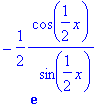Pivot et compagnie
Mise au point prétaupinale
1.5 Résolution de systèmes linéaires
1.5.1
> solve({2*x+2*y-3*z=2,y-6*z=-3,z=4});
![]()
> solve({2*x+2*y-3*z=2,-6*z=-3,z=4});
L'absence de réponse signifie en fait qu'il n'y a pas de solution.
> solve({2*x+2*y-3*z=2,6*z=24,z=4});
![]()
1.5.2
> solve({2*x+2*y-3*z=2,-2*x-y-3*z=-5,6*x+4*y+4*z=16});
![]()
1.5.4
> solve({2*x+y=4,x-3*y=9});
![]()
> solve({x+y+z=-4,2*x-y+2*z=-2,-3*x+y-z=-2,-3*x+y-z=-2});
![]()
> solve({x-y+z-t=-2,2*x-3*y+z+t=1,x+y+z+t=0,-x-y+3*z+2*t=-5});
![]()
> solve({x+y=2,2*x+2*y=17});
> solve({x+y=2,2*x+2*y=4});
![]()
> solve({x+y+z=3,2*x-y+4*z=2,4*x+y+6*z=8});
![]()
> solve({x+y+z+t=4,-x+y+2*z+t=2,2*x+y+3*z-t=-1,y+4*z-t=-3});
![]()
> solve({x+y+z+t=4,-x+y+2*z+t=2,2*x+y+3*z-t=-1,y+4*z-t=4});
Pas de solution...
> solve({x+y-z-t=2,2*x+3*y+z+t=4,3*x+5*y+3*z+3*t=6,4*x+5*y-z-t=8});
![]()
> solve({x+y=3,alpha*x+2*y=4},{x,y});
![]()
Il a fallu direà Maple quelles étaientles inconnues. Par ailleurs, Maple ne distinguepas le cas alpha=2...
> alpha:=2:solve({x+y=3,alpha*x+2*y=4},{x,y});
Pas de solution
> restart;
Pour lui faire oublier la valeur de alpha (il y avait plus léger, mais bon...)
> solve({x+y=3,alpha*x+2*y=6},{x,y});
![]()
> alpha:=2:solve({x+y=3,alpha*x+2*y=6},{x,y});
![]()
Comme quoi c'est perfide : il peut ne pas y avoir de division par alpha-2 dans le résultat, bien que le cas alpha=2 soit traité de façon fausse par Maple (en fait, Maple répond correctement à une question qui n'est pas celle qu'on croit...
> restart;
> solve({x+y+z=1,2*x+alpha*y-z=4,x-y+z=6},{x,y,z});
![]()
En fait, Maple ne considère pas alpha comme un paramètre au sens où nous on l'entend... avec du métier (après le cours d'algèbre linéaire !) vous pourrez comprendre ce qui suit : on y détecte les alpha qui posent problème, puis on traite éventuellement à part les cas particuliers.
> with(linalg):
Warning, the protected names norm and trace have been redefined and unprotected
> det(matrix([[1,1,1],[2,alpha,-1],[1,-1,1]]));
![]()
on sait alors qu'il y a toujours une unique solution...
> solve({x+y+z=1,2*x+alpha*y-z=4,x-y-z=6},{x,y,z});
![]()
> det(matrix([[1,1,1],[2,alpha,-1],[1,-1,-1]]));
![]()
> alpha:=-1:solve({x+y+z=1,2*x+alpha*y-z=4,x-y-z=6},{x,y,z});
Pas de solution.
> solve({x+2*y-z+t=0,x+y+z-3*t=0,x+3*y-3*z+5*t=0});
![]()
> solve({9*c+7*fr+3*h+2*fe+5*m=140,7*c+6*fr+4*h+5*fe+3*m=128,3*c+5*fr+7*h+6*fe+4*m=116,2*c+5*fr+3*h+9*fe+4*m=112,c+3*fr+2*h+8*fe+5*m=95});
![]()
4. Etudier une fonction
4.2 Limites
> limit((x^2+1)/(4+3*x^2+5*sqrt(x)),x=infinity);
![]()
> limit((1+x)*exp(x),x=infinity),limit((1+x)*exp(x),x=-infinity);
![]()
> limit(x^(1/x),x=0);
![]()
> limit(x^(1/x),x=0,right);
![]()
Capito ?
> limit(x^(1/x),x=infinity);
![]()
> limit((1+x)^(1/x),x=0);
![]()
> limit((1+2/n)^n,n=infinity);
![]()
4.4 Graphes
> plot((1+x)*exp(x^3));
Plotting error, empty plot
> plot((1+x)*exp(x^3),x=-2..2);
![[Maple Plot]](images/depart27.gif)
> plot((1+x)*exp(x^3),x=-2..0.1);
![[Maple Plot]](images/depart28.gif)
C'est mieux, non ? Il semblerait qu'il y ait une inflexion, non ? Sauriez-vous le prouver ?
> plot((x^2+1)/(4+x));
Plotting error, empty plot
> plot((x^2+1)/(4+x),x=-8..2);
![[Maple Plot]](images/depart29.gif)
> plot((x^2+1)/(4+x),x=-8..2,y=-3..3);
![[Maple Plot]](images/depart30.gif)
> plot((x^2+1)/(4+x),x=-10..2,y=-20..20,discont=true);
![[Maple Plot]](images/depart31.gif)
> plot((x^2+1)/(4+x),x=-15..10,y=-40..20,discont=true);
![[Maple Plot]](images/depart32.gif)
> asympt((x^2+1)/(4+x),x);

C'est ce qu'on appelle un développement asymptotique : les premiers termes fournissent l'asymptote.
5.4 Dériver/primitiver
> int(sin(3*t+5),t);
![]()
> diff(2*cos(3/t^2),t);

> diff(1/exp(sin(x/2)),x);

> diff(ln(1+cos(x)),x);
![]()
> diff(tan(1+sqrt(1+x^2)),x);
